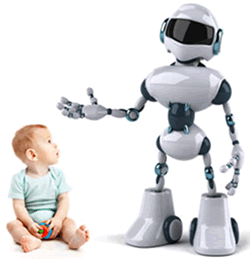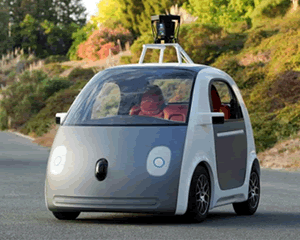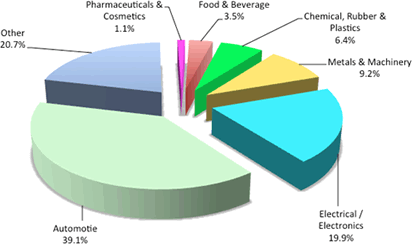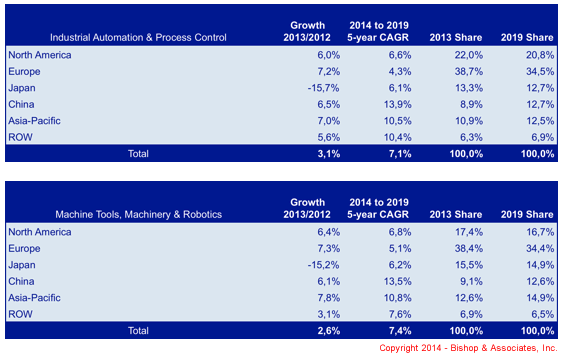Industrial Automation and Robotics: What’s Next?
We’ve reported often about robotics in the industrial arena over the last few years; now Bishop & Associates’s Arthur Visser looks at developments in industrial automation and robotics moving to the next level – service robots at home.
 “Where do I get the best robot deals?” In the not-so-distant future, you may ask yourself this question. Since everybody already has at least one TV set, car, dishwasher, washing machine, fridge, DVD player/recorder, home cinema system, computer, laptop, smartphone, tablet, and whatnot, the time has arrived for them all to communicate with each other and connect to the so-called “Internet of Things.” The next logical step is the introduction of service robots into people’s homes and linking to this network as well. By this we mean service robots that are far more capable than the domestic service robots (such as autonomous vacuum cleaners and lawnmowers) that we find in households already.
“Where do I get the best robot deals?” In the not-so-distant future, you may ask yourself this question. Since everybody already has at least one TV set, car, dishwasher, washing machine, fridge, DVD player/recorder, home cinema system, computer, laptop, smartphone, tablet, and whatnot, the time has arrived for them all to communicate with each other and connect to the so-called “Internet of Things.” The next logical step is the introduction of service robots into people’s homes and linking to this network as well. By this we mean service robots that are far more capable than the domestic service robots (such as autonomous vacuum cleaners and lawnmowers) that we find in households already.
The International Federation of Robotics (IFR) estimates that between 2013 and 2016 about 95,000 sophisticated service robots will be installed for professional use. These represent a value of $17.1 billion or $180,000 per robot, making the niche a growing market for connector manufacturers beyond industrial robots.
The Rise of Service Robots
 Service robots can be used in a variety of sectors to improve the quality of work, taking over dangerous, tedious, and dirty jobs that are not possible or safe for humans to perform. This means that robots are no longer the domain of factories and industrial plants but find their way into offices, hospitals, homes, and public places.
Service robots can be used in a variety of sectors to improve the quality of work, taking over dangerous, tedious, and dirty jobs that are not possible or safe for humans to perform. This means that robots are no longer the domain of factories and industrial plants but find their way into offices, hospitals, homes, and public places.
Collaboration between humans and robots is key to opening up these new markets and applications beyond automotive and semiconductor manufacturing, where robots have been on the factory floor for decades. Due to technological advances, it is now much safer to let robots “out of their cages.” Automotive manufacturers already introduced robots to the assembly line to work together with human workers. As a result, the use of service robots, a domain where collaboration with humans is essential, is on the rise now that technology makes it safe to do so.
In addition, big international companies are moving into the robotics market via acquisitions and their own R&D.
 Google acquired eight start-up companies last year, including Boston Dynamics, a military robot manufacturer, and Deepmind, a British artificial intelligence company. In addition, Google is testing its own built-from-scratch-in-Detroit self-driving car. The battery-powered electric vehicle has as a stop-go button, but no steering wheel or pedals.
Google acquired eight start-up companies last year, including Boston Dynamics, a military robot manufacturer, and Deepmind, a British artificial intelligence company. In addition, Google is testing its own built-from-scratch-in-Detroit self-driving car. The battery-powered electric vehicle has as a stop-go button, but no steering wheel or pedals.
Amazon also joined the club and bought Kiva Systems, a maker of logistics robots. In addition, Amazon recently made news with a statement that it wants to start delivering packages using drones.
There are already service robots available for:
- Offices, used for cleaning or other routine jobs
- Hospitals, dealing with laundry and waste products but also in the operation room for surgery
- Inspecting hazardous areas such as nuclear power stations or areas where there is a danger for explosions
- Home, to help with household chores and/or help the elderly and sick
- Educational/institutional applications
Healthcare is generally considered a promising and growing market for service robots. Besides these civil applications, the defense sector is using a lot of robots, too. The military is the biggest single market for robots besides the industrial market. Another large market is agriculture.
Boom in Industrial Robots
Parallel to an expected breakthough of service robots, there is also a rise in the use of industrial robots. In 2013, a record 179,000 industrial robots were sold worldwide according to the IFR, and every fifth robot sold in the world was installed in China. Automotive and metal industries were the main drivers for growth in 2013. Bookings for the first four months of 2014 increased significantly in all market sectors, promising another sales record for the full year 2014.
 For industrial robots, the automotive market was by far the largest market in 2013 with 39% of total sales. Next was the electronics/electrical market with 20% of sales and the metals and machinery market followed in third place. Compared to 2012, the market for industrial robots grew by 12% in 2013.
For industrial robots, the automotive market was by far the largest market in 2013 with 39% of total sales. Next was the electronics/electrical market with 20% of sales and the metals and machinery market followed in third place. Compared to 2012, the market for industrial robots grew by 12% in 2013.
Robotics is, of course, only part of the industrial market for connectors. Machine tools and machinery make up a very important part of this market as well, along with industrial networks and automation equipment, which includes PLCs (Programmable Logic Controllers), process control equipment, actors/sensors drives, and mechatronics. At Bishop & Associates we have split this equipment into two major areas: (1)industrial automation and process control and (2) machine tools, machinery, and robotics. These two equipment sectors represent more than two-thirds of the industrial market for connectors and are key to the future growth and direction of this end-use equipment sector.
What Drives Development?
Looking forward, key technology drivers of the industrial market include:
- Energy-efficiency of machinery and production methods
- Use of new materials, e.g. carbon composites and ultra-light structures which will require new production methods
- Globalization resulting in increased competition, in turn triggering a demand for increased productivity and higher quality
- Broadening consumer markets as a result of growing middle classes in emerging economies, requiring expansion of production capacities and capabilities
- Decreasing life cycles of products and increased customization (one-to-one marketing), requiring flexible production and automation
- Increased adaptability, resource efficiency, and ergonomics on the factory floor
- Integration of customers and business partners in business and value processes
At Bishop & Associates we have tried to quantify these technologies and estimate what that means to connector sales into these markets. The next two tables provide insight into the connector sales’ growth rates for industrial automation and process control, as well as machine tools, machinery, and robotics for the year period between 2014 and 2019 by region. It is clear that China and Asia-Pacific will enjoy the highest growth rates, followed by the ROW region, increasing their shares of the world market significantly in the next five-year period.
Connector Sales Growth and Share by Region: 2013 and 2014-2019

Arthur Visser, VP, Bishop & Associates, Inc.
- The Industrial Market for Connectors in a Changing World - April 20, 2021
- How Key Trends in the Transportation Market Will Impact Electronics Growth - March 17, 2020
- Automation Means a Bright Forecast for Industrial Connectors - February 19, 2019





